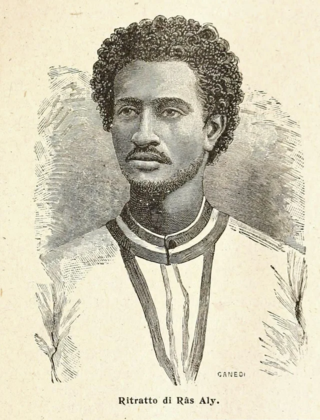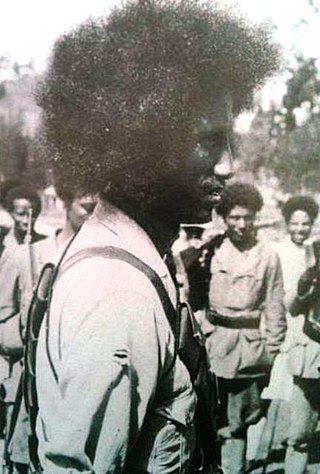Reign
After their brother Yimam's death Marye quickly seized the office of Ras, despite the armed resistance of Dori. [1]
With his brother Dori led the Yejju forces in the Battle of Debre Abbay on 14 February 1831; his brother was killed in the savage battle, and as a result Dori had his followers ravage Tigray. [2]
While he was with his followers pillaging the countryside outside of Axum, Ras Dori became ill. According to Samuel Gobat, not trusting his subordinates the Ras put half of them in chains, then returned to Debre Tabor where he died towards the end of May. [3] His only significant act while Inderase was to depose Emperor Gigar on 18 June, and replace him with Iyasus IV.
Egwale Seyon, throne name Newaya Sagad, was Emperor of Ethiopia from June 1801 to 12 June 1818, and a member of the Solomonic dynasty. He was the son of Hezqeyas.
Gigar was Emperor of Ethiopia intermittently between 1821 and 1830, and purportedly a member of the Solomonic dynasty.

Debre Tabor is a town and woreda in northern Ethiopia. Located in the Debub Gondar Zone of the Amhara Region, about 100 kilometers southeast of Gondar and 50 kilometers east of Lake Tana, this historic town has a latitude and longitude of 11°51′N38°1′E with an elevation of 2,706 metres (8,878 ft) above sea level. The presence of at least 48 springs in the area contributed to the development of Debre Tabor.
Marye of Yejju was a Ras of Begemder and Enderase (regent) of the Emperor of Ethiopia. He was the brother of his predecessor Ras Yimam.
Gugsa of Yejju was a Ras of Begemder, and Inderase (regent) of the Emperor of Ethiopia. According to Nathaniel Pearce, he took the Christian name of Wolde Mikael. He was the son of Mersu Barentu and Kefey, the sister of Ras Aligaz. Both Bahru Zewde and Paul B. Henze consider his reign as Ras and Enderase as the peak of the Yejju Dynasty during the Zemene Mesafint.
Yimam of Yejju was a Ras of Begemder and Enderase (regent) of the Emperor of Ethiopia. He was the son of Gugsa of Yejju.
Aligaz of Yejju was Ras of Begemder, and Inderase (regent) of the Emperor of Ethiopia. He was the son of Abba Seru Gwangul and brother of Ali I of Yejju; he became both Ras and Inderase following Ali's death. Aligaz had four sons: Dejazmach Birru, Dejazmach Gobeze, Dejazmach Faris, and Dejazmach Gojjee.
Ali I of Yejju was Ras of Begemder, and following the death of Ras Mikael Sehul, Regent of the Emperor of Ethiopia. He was the son of Abba Seru Gwangul, chieftain of the Yejju, and Woizero Gelebu Faris, daughter of Ras Faris of Lasta.

Ali II of Yejju was Ras of Begemder and the de facto ruler of the Ethiopian Empire. He was a member of a powerful Oromo dynasty known as the Yejju, which ruled much of the Ethiopian Empire during the Zemene Mesafint.

Mikael Sehul was a nobleman who ruled Ethiopia for a period of 25 years as regent of a series of emperors. He was also a Ras or governor of Tigray 1748–71 and again from 1772 until his death. He was a major political figure during the reign of Emperor Iyasu II and his successors until almost the time of his death.

Sabagadis Woldu was a governor of Tigray Province of the Ethiopian Empire from 1822 to 1831. Sabagadis gained some notoriety in the first decade of the 19th century for rebelling a number of times against his overlord, Ras Wolde Selassie. But just before the death of Wolde Selassie it seems that he made up with his master and became one of his loyal lieutenants. Following Wolde Selassie's death in 1816, he defied the authority of Wolde Selassie's son, and became the most powerful warlord in Tigray. Making Adigrat his capital, he ruled Tigray and a small strip of the coastal plains of Eritrea by 1818. His rule also extended to the Eritrean highlands.
Wossen Seged was a Merid Azmach of Shewa, an Amhara noble of Ethiopia. He was the elder son of Asfa Wossen, by a woman of the Solomonic dynasty. He was the first ruler of Shewa to claim a higher title than Merid Azmach, calling himself Ras.

Sahle Selassie was the King of Shewa from 1813 to 1847. An important Amhara noble of Ethiopia, he was a younger son of Wossen Seged. Sahle Selassie was the father of numerous sons, among them Haile Melekot, Haile Mikael, Seyfe Sahle Selassie, Amarkegne and Darge Sahle Selassie; his daughters included Tenagnework, Ayahilush, Wossenyelesh, Birkinesh, and Tinfelesh.
The Battle of Debre Abbay, also known as the Battle of Mai Islami, was a conflict between Ras Marye of Yejju, regent of the Emperor of Ethiopia, and his rival from Tigray, Dejazmach Sabagadis of Agame. Although Ras Marye lost his life in the battle, Dejazmach Sabagadis was defeated and executed by Ras Marye's followers after surrendering.

RasMengesha Yohannes was governor of Tigray and a son of atse Yohannes IV. His mother was Welette Tekle Haymanot wife of dejazmach Gugsa Mercha. Ras Araya Selassie Yohannes was his older half brother. Prior to the Battle of Metemma, Mengesha Yohannes was considered to be a nephew of Emperor Yohannes IV. During the battle, the Emperor was mortally wounded and it was on his deathbed that Mengesha Yohannes was acknowledged as his "natural" son and designated as his heir. This created something of a succession problem.

The Zemene Mesafint was a period in Ethiopian history between the mid-18th and mid-19th centuries when the country was ruled by a class of Oromo elite noblemen who replaced Abyssinian nobility in their courts, making the emperor merely a figurehead. For the most part, the regional lords were tightly related by marriage and constituted a stable ruling elite that prevailed until the mid 20th century. In short, during the Zemene Mesafint, the Emperors from the Solomonic dynasty were reduced to little more than figureheads confined to the capital city of Gondar.

Belay Zeleke was an Ethiopian military commander who led the Arbegnoch resistance movement in Gojjam against the Fascist Italians during the Italian occupation of Ethiopia from 1936 to 1941. He emerged as a brigand leader after his five-year struggle against Italian rule in Ethiopia.

Wube Haile Maryam of Semien, (1799–1867), also called by his title Dejazmach Wube, Webé; his name is also given in European sources as ‘‘Ubie’’, was one of the major figures of 19th century Ethiopia, during the closing decades of the Zemene Mesafint a period of regional lords vying for power, prestige and territory amid a weakened authority of the emperors.
Menen Liben Amede was Empress consort of Ethiopia by marriage to Emperor Yohannes III in 1840–1841, 1845 and 1850–1851.
Betul Haile Maryam was a member of the Semien nobility through his paternal line.








